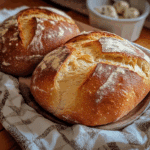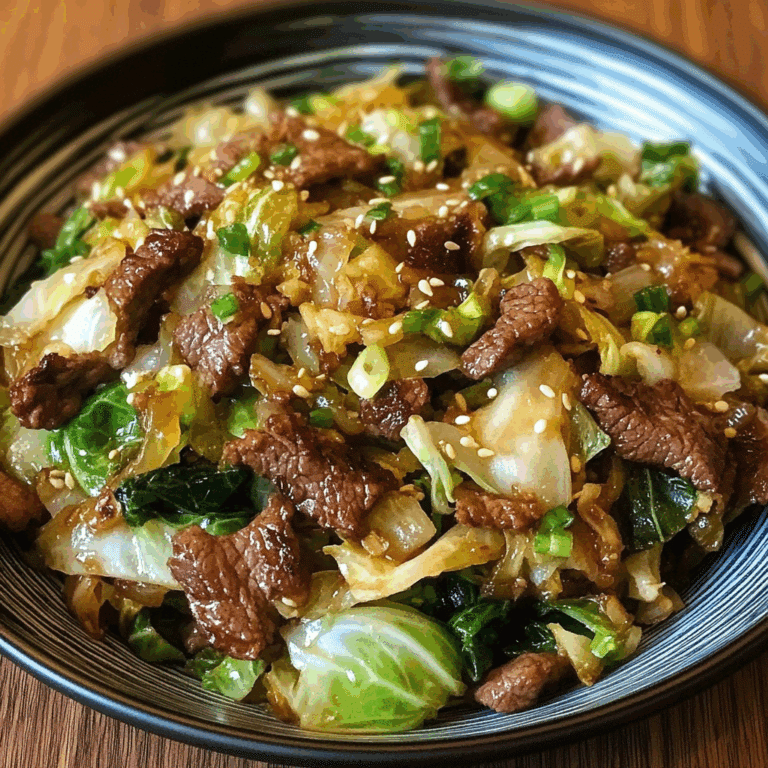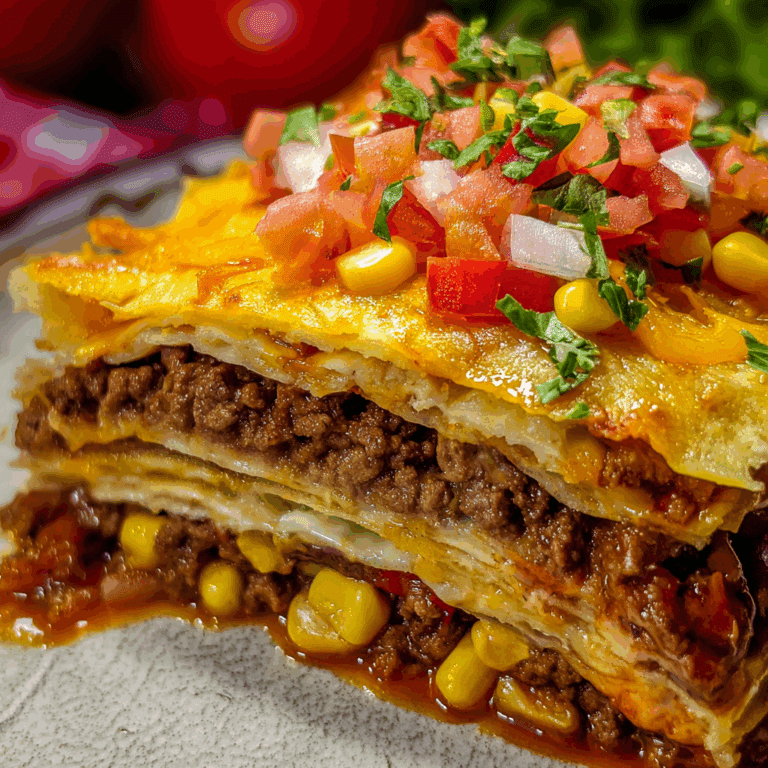How to Make Homemade German Bread Easily

If you’ve ever wanted to bring the rich, hearty flavors of Germany right into your kitchen, you’re in for a treat. This easy-to-follow guide to making Homemade German Bread will walk you through every step, using simple ingredients and techniques that anyone can master. From crusty artisan-style surfaces to soft, flavorful interiors, this bread captures the essence of traditional German baking in a way that’s perfect for beginners and bread lovers alike.
Why You’ll Love This Recipe
- Authentic Taste: Enjoy the genuine, earthy flavors that make German bread a classic.
- Simple Ingredients: Uses basic pantry staples that are easy to find yet bring complex flavor.
- Beginner-Friendly: No need for fancy equipment or complicated steps.
- Versatile: Perfect for sandwiches, toasts, or alongside your favorite meals.
- Impressive Results: Produces a bakery-quality loaf that looks and tastes wonderful.
Ingredients You’ll Need
Getting started with Homemade German Bread is surprisingly straightforward thanks to its simple, natural ingredients that combine to create depth, texture, and that iconic crust.
- All-Purpose Flour: The foundational element providing structure and a neutral flavor base.
- Rye Flour: Adds earthiness and traditional German bread complexity.
- Warm Water: Activates the yeast and hydrates the flours for perfect dough consistency.
- Active Dry Yeast: Essential for the bread’s rise and fluffy crumb.
- Sourdough Starter (optional): Enhances flavor and lends a slight tang typical to many German breads.
- Salt: Balances taste and improves dough elasticity.
- Caraway Seeds (optional): For a traditional aromatic twist that many German breads include.
Variations for Homemade German Bread
Want to make the recipe uniquely yours? These variations allow you to adapt the bread to different tastes, dietary needs, or what you have on hand.
- Whole Wheat Twist: Substitute some or all of the flour with whole wheat for a nuttier, denser loaf.
- Gluten-Free Version: Use a gluten-free flour blend and adjust hydration accordingly to create a tasty alternative.
- Seeded Crunch: Add sunflower, pumpkin, or flax seeds for extra texture and nutrition.
- Herb Infusion: Mix fresh or dried herbs like rosemary or thyme into the dough for an aromatic punch.
- Sweet Version: Incorporate a touch of honey or molasses for a slightly sweet undertone balancing the rustic flavors.

How to Make Homemade German Bread
Step 1: Prepare Your Ingredients
Measure out your flour, rye flour, salt, and any seeds or spices if using. Warm the water to about 110°F to activate the yeast properly without killing it. If using a sourdough starter, ensure it is bubbly and active before adding.
Step 2: Activate the Yeast
In a small bowl, dissolve the active dry yeast in the warm water along with a pinch of sugar, allowing it to foam for around 5 to 10 minutes, indicating it’s ready to work.
Step 3: Mix the Dough
In a larger bowl, combine your flours, salt, and optional caraway seeds. Pour in the yeast mixture and stir until it forms a shaggy dough. Then, knead by hand or with a stand mixer for 8-10 minutes until the dough becomes smooth and elastic.
Step 4: First Rise
Place the dough in a lightly oiled bowl and cover it with a damp cloth or plastic wrap. Let it rise in a warm spot for about 1 to 1.5 hours, or until it doubles in size, which helps create that airy crumb.
Step 5: Shape the Loaf
Gently punch down the dough to release the air. Shape the dough into a round or oval loaf and place it on a parchment-lined baking tray or in a bread proofing basket for traditional texture.
Step 6: Second Rise
Cover the dough and let it rest for another 30-45 minutes to develop a light crust during baking.
Step 7: Bake
Preheat your oven to 450°F (230°C). Score the top of the loaf with a sharp knife to control expansion, and bake for 20 minutes. Reduce the temperature to 400°F (200°C) and bake an additional 15-20 minutes until golden brown with a crispy crust.
Step 8: Cool and Enjoy
Let your Homemade German Bread cool completely on a wire rack to finish baking and set the crumb. This step ensures the perfect texture for slicing and serving.
Pro Tips for Making Homemade German Bread
- Use Quality Flours: Fresh, high-protein flours lead to better dough development and taste.
- Temperature Control: Keep ingredients and rising environments warm but not hot to optimize yeast activity.
- Don’t Rush the Rise: Allowing the dough enough time to double ensures a tender crumb and great volume.
- Steam During Baking: Add a pan of hot water to your oven to create a steamy environment, improving crust crispness.
- Practice Scoring: Scoring the dough helps control its expansion and prevents cracking.
How to Serve Homemade German Bread
Garnishes
Sprinkle bread with coarse sea salt or extra seeds right before baking for an inviting look. After baking, a light brush of melted butter can add rich flavor and shine.
Side Dishes
This bread pairs beautifully with classic German meals such as sausages, sauerkraut, and hearty stews, or try it with cheese, smoked meats, and pickles for a true taste sensation.
Creative Ways to Present
Slice and toast for a rustic open-faced sandwich, or serve thick-cut with homemade dips like mustard or herb butters to elevate a simple snack into an impressive appetizer.
Make Ahead and Storage
Storing Leftovers
Wrap leftover bread tightly in plastic wrap or place in an airtight container to keep it fresh at room temperature for 2-3 days without drying out.
Freezing
Slice the bread first, then freeze in ziplock bags for convenience, allowing you to take out exactly what you need and extend freshness up to 3 months.
Reheating
Reheat slices in a toaster or warm whole loaves in a preheated oven at 350°F (175°C) for 10 minutes to restore the crust’s crunch and the interior’s softness.
FAQs
Can I make Homemade German Bread without rye flour?
Yes, you can substitute rye flour with all-purpose or whole wheat flour, though you may lose some of the authentic flavor and texture typical of German bread.
How long does Homemade German Bread stay fresh?
When stored properly at room temperature, it stays fresh for about 2 to 3 days; refrigeration can dry it out faster, so avoid chilling if possible.
Is it necessary to use a sourdough starter?
No, sourdough starter is optional for this recipe. It adds complexity and tang but the bread turns out delicious with just yeast as well.
Why is scoring the bread important?
Scoring helps control where the bread expands during baking, preventing random cracks and ensuring a beautiful appearance and texture.
Can I add seeds on top of the bread?
Absolutely! Seeds like sesame, poppy, or caraway can be sprinkled on top before baking for extra crunch and flavor.
Final Thoughts
There’s something truly special about pulling a warm loaf of Homemade German Bread from your own oven. Not only does it fill your kitchen with irresistible aromas, but it also offers a satisfying experience from start to finish. Whether you’re a novice baker or simply someone who loves hearty bread, this recipe invites you to enjoy the authentic flavors of Germany with minimal fuss. So gather your ingredients, get your hands doughy, and savor the joy of baking this classic bread right at home!
Related Posts
PrintHomemade German Bread
Homemade German Bread offers an authentic taste of traditional German baking with a crusty artisan-style exterior and soft, flavorful interior. Using simple pantry staples and easy techniques, this beginner-friendly recipe creates a versatile bakery-quality loaf perfect for sandwiches, toasts, or accompanying your favorite meals.
- Prep Time: 20 minutes
- Cook Time: 40 minutes
- Total Time: 2 hours 30 minutes
- Yield: 1 loaf (about 12 slices) 1x
- Category: Breads
- Method: Baking
- Cuisine: German
- Diet: Vegetarian
Ingredients
Main Ingredients
- 3 cups all-purpose flour
- 1 cup rye flour
- 1 1/4 cups warm water (about 110°F)
- 2 1/4 tsp active dry yeast (1 packet)
- 1 tbsp salt
Optional Ingredients
- 1/2 cup sourdough starter (active and bubbly)
- 1 tsp caraway seeds
Instructions
- Prepare Your Ingredients: Measure the all-purpose flour, rye flour, salt, and optional seeds or spices. Warm the water to about 110°F to activate the yeast without killing it. If using sourdough starter, ensure it is active and bubbly before adding.
- Activate the Yeast: In a small bowl, dissolve the active dry yeast in warm water with a pinch of sugar. Let it foam for 5 to 10 minutes to indicate readiness.
- Mix the Dough: In a large bowl, combine flours, salt, and optional caraway seeds. Pour in the yeast mixture (and sourdough starter if used). Stir until a shaggy dough forms, then knead by hand or mixer for 8-10 minutes until smooth and elastic.
- First Rise: Place the dough in a lightly oiled bowl, cover it with a damp cloth or plastic wrap, and let it rise in a warm spot for 1 to 1.5 hours until doubled in size.
- Shape the Loaf: Punch down the dough gently to release air. Shape it into a round or oval loaf and place it on a parchment-lined baking tray or in a proofing basket.
- Second Rise: Cover and let the dough rest for 30-45 minutes to develop a light crust before baking.
- Bake: Preheat oven to 450°F (230°C). Score the top of the loaf with a sharp knife to control expansion. Bake for 20 minutes, then reduce temperature to 400°F (200°C) and bake for another 15-20 minutes until golden brown and crusty.
- Cool and Enjoy: Transfer the bread to a wire rack and let it cool completely to finish baking and set the crumb for perfect slicing.
Notes
- Use fresh, high-protein flours for better dough development and taste.
- Keep ingredients and rising environment warm but not hot to optimize yeast activity.
- Allow the dough enough time to double in size for a tender crumb and great volume.
- Adding steam to the oven by placing a pan of hot water improves crust crispness.
- Score the dough before baking to control expansion and avoid random cracks.
Nutrition
- Serving Size: 1 slice (about 60g)
- Calories: 160
- Sugar: 1 g
- Sodium: 300 mg
- Fat: 1 g
- Saturated Fat: 0.2 g
- Unsaturated Fat: 0.5 g
- Trans Fat: 0 g
- Carbohydrates: 32 g
- Fiber: 3 g
- Protein: 5 g
- Cholesterol: 0 mg
Keywords: German bread, rye bread, artisan bread, homemade bread, crusty bread, traditional German baking







